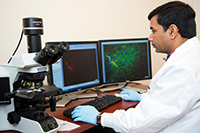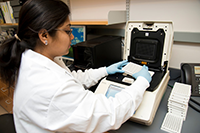Liver disease studies underscore obesity's impact on health
February 21, 2014

A study by Dr. Ratanesh Kumar Seth, a post-doctoral fellow, recently appeared in the journal Toxicology and Applied Pharmacology.

Graduate student Suvarthi Das led a study on NASH published in the American Journal of Physiology - Gastrointestinal and Liver Physiology.
When a study on a "silent" liver disease, known as nonalcoholic steatohepatitis (NASH), was published in the January issue of the journal Toxicology and Applied Pharmacology, the report was another example of the quality of research being done in the lab of Dr. Saurabh Chatterjee.
The publication was the 11th peer-reviewed study to appear in a prestigious journal in approximately a year's time and from the lab of a new faculty member who joined the Arnold School's Department of Environmental Health Sciences in July 2012. Of interest also is that the study's first author is post-doctoral fellow Dr. Ratanesh Kumar Seth, who came to USC to work Chatterjee's lab because of the scholar's reputation as a scientist. The journal article followed one led by doctoral student Suvarthi Das in December in the American Journal of Physiology - Gastrointestinal and Liver Physiology.
"I encourage graduate students and post-doctoral fellows to have their own individual projects. Their studies increase the productivity of our lab and also result in the publication of research findings," said Chatterjee, who came to the Arnold School from the National Institute of Environmental Health Sciences after being trained in free radical toxicology at NIEHS and obesity-induced NASH at Duke University.
Chatterjee's lab is the first to establish connections between environmental toxins and NASH, which is increasing in prevalence because of the obesity epidemic.
"Obesity is a huge public health problem in the United States and increasing internationally," he said. "Approximately one-third of American adults are obese. If the trend continues, 62 percent will be obese by 2025. As a result, our research on NASH is increasingly important."
Scientific and medical interest in NASH is growing. Affecting as many as 5 percent of Americans, NASH resembles the type of liver disease prevalent in alcoholics. Yet, it occurs in people who drink little or no alcohol. One of the most prevalent aspects of NASH is fat in the liver. Although liver inflammation and damage can occur, most people have no symptoms. The danger is that can the damage can lead to cirrhosis, a condition in which the liver no longer functions properly.
"People need to be examined for this disease and know the risks," he said.
Less serious is a condition known as nonalcoholic fatty liver disease (NAFLD), characterized by having fat in the liver but with no inflammation or liver damage. Between 10 and 20 percent of Americans have fat in their liver. Having fat in the liver is not normal and undesired medically because it could lead to metabolic complications, including insulin and leptin resistance, and make an individual susceptible to chronic inflammatory diseases.
However, the prevalence and interest in NASH and NAFLD indicate the need for a better understanding of the toll that obesity can have on the body.
Chatterjee, who was working at the National Institute of Environmental Health Sciences, came to the Arnold School with a commitment to better understand the roles that the environment and the built environment have on obesity and an individual's health.
Seth's study was the first to identify that the CD57 protein increases with the progression of NASH. The significance for the finding is that this molecule could be used as a biomarker, which is a measure or indicator of a disease. The study by Das is important for key findings that may be beneficial for the treatment of NASH.
Chatterjee has assembled an international team of young researchers from Iran, Iraq and India who are focused on the impact of environmental toxins on human health. With a foundation of impressive publications and findings already, the lab also has reached another milestone. It is now firmly established in its new "digs" in the Discovery 1 building, which is part of the University's research campus.
Public health research faculty moved from the former Health Sciences building to Discovery 1 in November. Others, like Chatterjee who had been in the Public Health Research Center, also moved to Discovery.
The move is important in accommodating the Arnold School's growing research program.
"Our move has doubled the size of our original lab," said Chatterjee. "The opportunities that I have here at the Arnold School exist because of the dedication of our dean, Dr. Tom Chandler, Dr. (Dwayne) Porter, who leads the Department of Environmental Health Sciences, and Dr. Greg Hand, who leads the school's research office. Their support of my work and that of other young faculty is greatly appreciated. The Dean meets with us and our students. It is good for young researchers and faculty to have this type of interest and support."
Chatterjee's research is part of the Arnold School's success story.
"Our goal is to produce quality scientific research and publish our findings in good scientific journals. This is a measure of productivity and accountability, and we want to engage in research that will have direct application on the health of South Carolina and, in turn, our nation," he said.



_01.jpg)
_02.jpg)